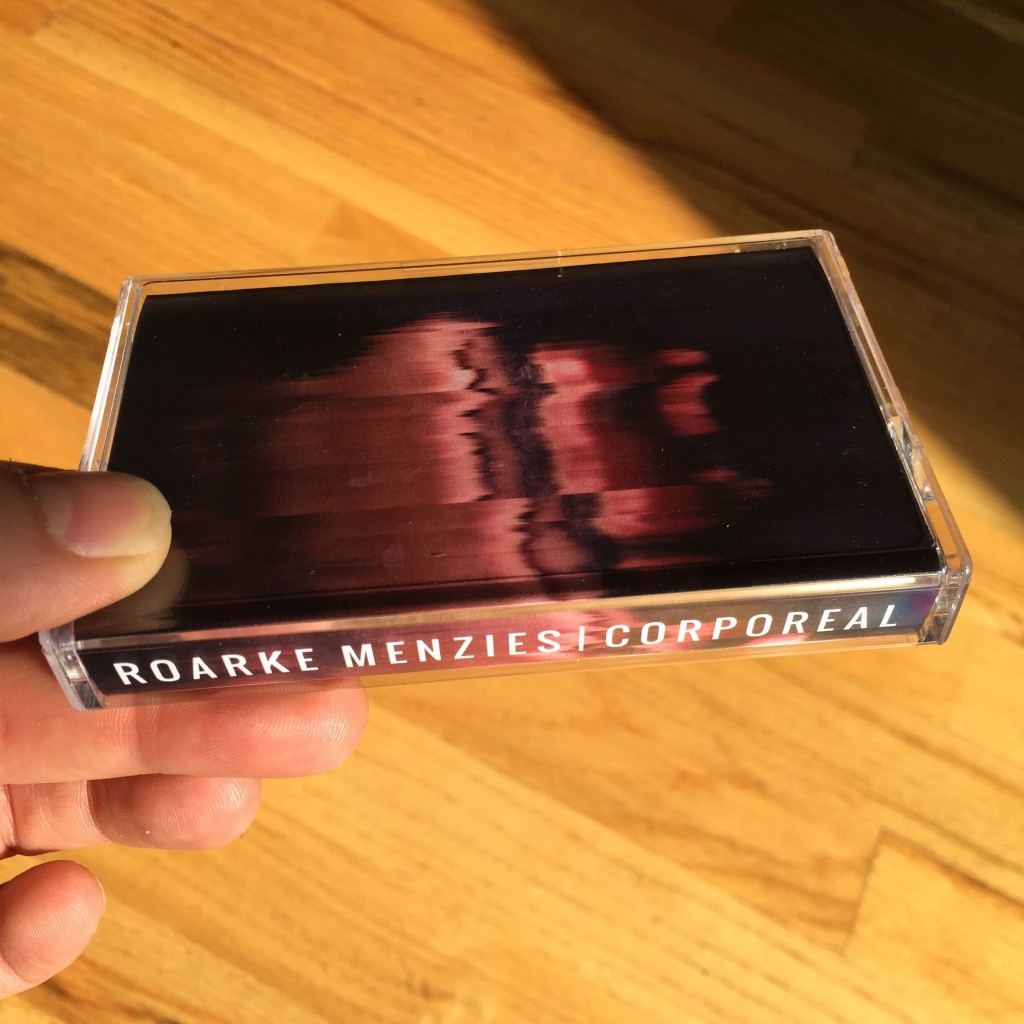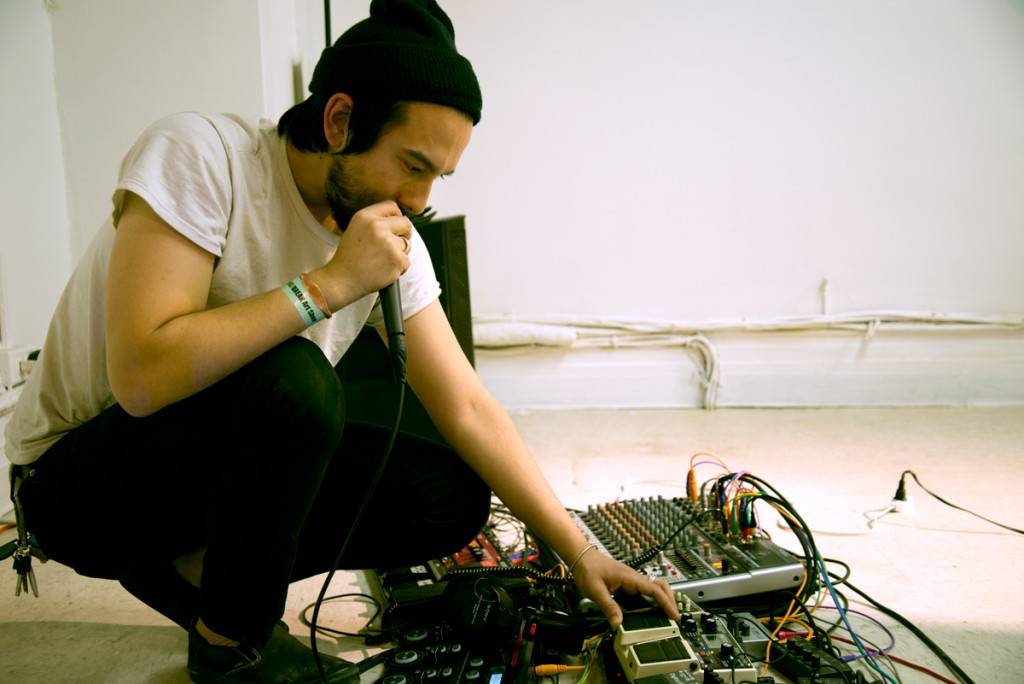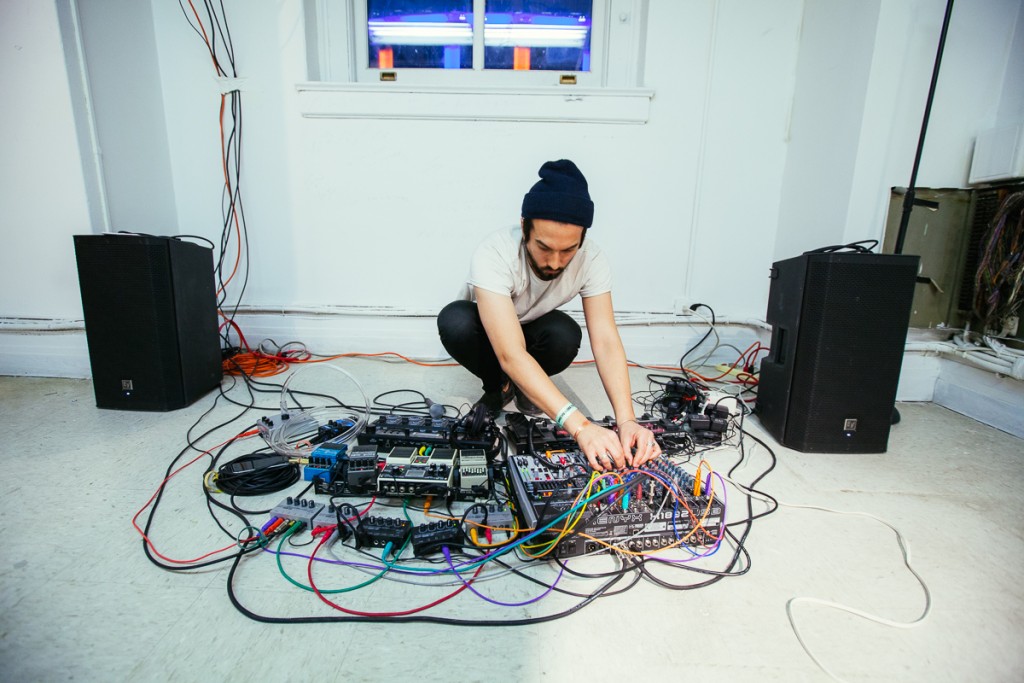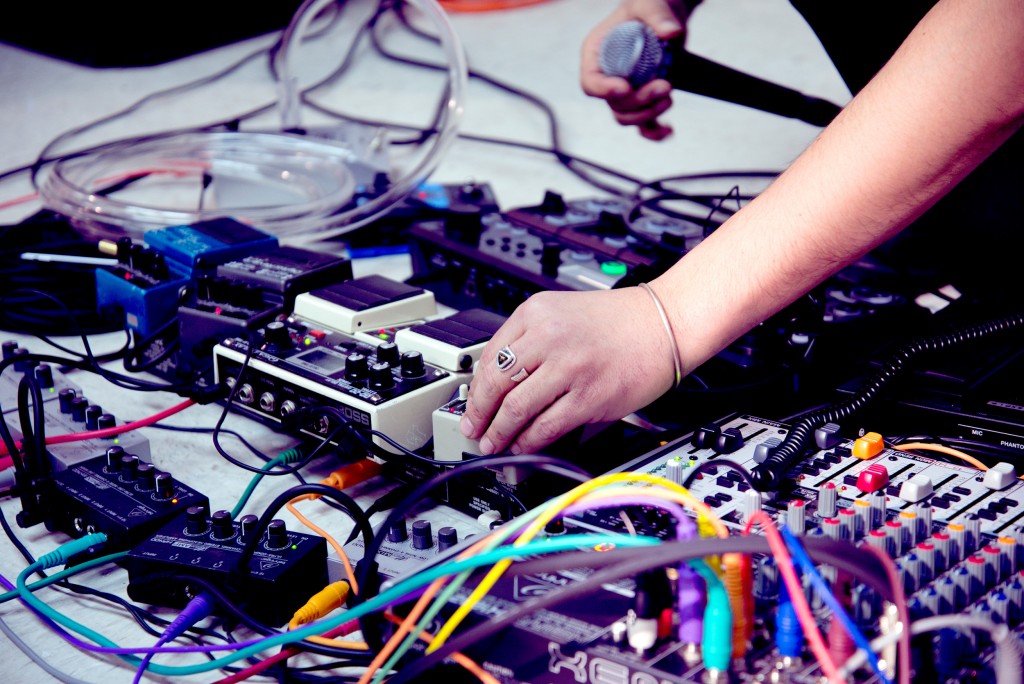Interview with Composer and Sound Artist Roarke Menzies

LINDSAY BENEDICT: In your new album Corporeal, the body is your main instrument. With voices moaning, hands laboring, feet dancing, and fists pounding, the album negotiates between human and machine with the body in performance. When I think of the body, I think of a rich mess that responds to impulses before the filter of the rational mind. What compelled you to use the body as your primary sound source?
ROARKE MENZIES: When I first started putting together my audio pedal collection in 2007, I thought of these devices as extensions of my instrument, like my instrument was no longer just my voice, but the composite of my voice with x. I was interested in the cyborg as a symbol and with the idea that, as our identities are increasingly intertwined with electronic and digital media, we are already cyborgs, whether or not it is expressed anatomically (e.g. bionic arms, laser eyes, etc.).
At some point I stopped thinking of my music that way, like the idea was no longer radical to me, but I continued developing my relationship with these tools, mostly in the studio for soundtrack work and other side projects. Now that I’m focusing on my solo work in this manner, the machine-human relationship has resurfaced to me as a central concern. And in the interim years, my relationship with these specific machines has become so intimate, so familiar — with layers of deeply ingrained muscle memory — that the notion of these machines as an extension of my body instrument is much more ‘real’ than ever.
 Photo Credit: Precede/Proceed
Photo Credit: Precede/Proceed
LB: We’ve known each other since our early Bushwick years but have recently crossed paths because of our developing artistic and audio realms. Last summer, I ran into you at Daniel Neumann’s Non-representational Spatial Sound Composition Workshop at Knockdown Center during the Ende Tymes V Festival of Noise and Abstract Liberation (I was very pregnant at the time). You introduced me to an early version of Corporeal at that time. What have you been up to since then?
RM: Yeah, that workshop was excellent. I actually didn’t get to participate because of my work schedule, but I showed up to hear everyone present their work and actually made a few new friends. It was great.
There’s been a ton going on for me since then, some of it really wonderful — a collaboration with Jack Ferver and Marc Swanson at the New Museum, a commission from the Larry Keigwin Company with choreographer Adam Barruch at the Joyce Theater. I also released my first album in October, which was meaningful in all those semi-corny ‘life goal’ ways. And I’ve since been doing a lot more solo sound performances. A big highlight was performing in Material Art Fair in Mexico City. Leah Dixon, of Beverly’s, put together a group show and we all went down there in February.
Meanwhile, after taking some time away from Corporeal, I returned to that material a few times in November and then January and February to finish the editing and mixing. The basic structure of the album is pretty much the same as what I sent you last summer, but I’ve done quite a lot since then to dial in the individual tracks.
LB: Next, we ran into each other at Hito Steyerl’s Artists Space exhibition. Her work, sometimes referred to as post-internet, is attuned to the mutability of our increasingly globalised and digitised world. I find that your fourth track, “Apparatus or Caress”, plays with a controlled mediation of information. When working with the body as your source audio, how do you decide what processes, be they digital or other, to enact?
RM: My process tends to be very intuitive. Recording sessions usually begin with me improvising using a microphone plugged into several audio effects units, and in a lot of ways the improvisation continues through the editing and arranging process. I try different things and see where they lead me, and usually certain threads will emerge that I follow and focus on.
Actually, “Apparatus or Caress” is one of a handful of tracks here where I’m using something called ‘sidechain compression’. It’s commonly used on the radio when a host or announcer starts talking over the music and the level of the music automatically ‘ducks’ to make room for the voice. Their microphone signal is being sent to a compressor, which essentially mutes or turns down the music whenever the host is talking. But if the host pauses long enough between words, the level of the music automatically slides back up to its original level before dipping down when again when the host continues their sentence.
 Photo Credit: Joshua Simpson
Photo Credit: Joshua Simpson
This is a technique that comes straight out of communication theory, which deals directly with the mediation of information (message, sender, signal, noise, etc.). I’d been curious for a while about experimenting with this in my practice. For instance on “Escape Artist,” I’m using multiple layers of sidechain compression on several different channels, so there’s almost like a tug of war taking place — different signals competing for audibility.
LB: Similarly, in your last track “Hum” we hear a discordant raw moaning. I feel it sometimes falls to bees buzzing and at other times falls to digital arpeggio. Does this album seek to renegotiate the boundary between nature and digital?
RM: If I’m honest, chances are this album — like David Bowie’s body of work, or Tupac’s or Michael Jackson’s or any other, much lesser known dead musician with recordings on Spotify — will likely outlive my own body. Similarly, the list of friends of mine who have been survived by their Facebook profiles continues to grow. I feel like the boundary (if there is one) between nature and digital is being constantly renegotiated at this point. It’s certainly something being addressed here.
LB: Matmos, the electronic music duo, gained notoriety in early 2000s for their use of audio samples which included freshly cut hair, amplified neural activity of crayfish, and various surgical procedures; they then created accessible, melodic pieces of experimental techno. In “For Vinyl-Covered Stages” we can actually hear the sound of feet stomping and the energy transferring from foot to stage. Does your album rely heavily on audio samples? And how conceptual is your choice of sound source?
RM: Because of my approach to editing and collaging on this album, you could almost consider everything on it to be an ‘audio sample’. But the sound sources are definitely very focused. Nearly all of it comes from my voice, mouth or breath, although on certain tracks I developed some of the material by banging on things, like hitting my old wooden desk with a drumstick or beating my fists against a big steel shelf I used to have.
I was interested in keeping a very tactile, visceral relationship to the signal chain while recording — always generating sounds via physical action and then responding to what I heard either by manipulating the hardware settings with my hands or making a new sound in response. Sometimes I’d be hitting something, listening to the machines echo back and then singing or making a sound with my mouth, tweaking a knob then hitting something again. It was all very immediate and spontaneous, very impulse-driven.
On “For Vinyl-Covered Stages” I used two field recordings: one of a performance by the choreographer Michelle Mola, in which three dancers in wooden-soled character shoes leap and shuffle across a stage; the other of an old, hand-cranked sewing machine that lives in the costume shop at the Juilliard School.

LB: Furthermore, I saw you perform live at Spring/Break a work called Permeate/Permutate in which the actual gallery was transformed into a cavernous body of sorts. Do you draw strict boundaries between your body and the body of another? And/Or how you are defining anatomy?
RM: I mean, to not acknowledge any boundaries between one’s own body and the body of another sounds potentially dangerous, like serial sex offender status or something. Obviously there are levels to which this body talk is metaphorical, and there are levels to which it’s very literal — for instance, a low, loud sound travels quite literally through one’s entire body, therefore both literally and poetically linking one’s interior and exterior.
I guess what attracts me to these human/machine sound technologies is in part coming from a curiosity and an interest in engendering new configurations in the metaphorical language around the body, anatomy, machinery, the built environment, digital landscapes, identities, etc.. One reference point is Marshall McLuhan’s notion that all electronic media are extensions of the nervous system. But for me it’s also partly about exploring possible worlds, asking “what else is there?” or “what else can there be?”
LB: Describe the many ways in which physicality was used?
RM: There’s a kind of micro-choreography that guides the physical/acoustic/material exchange between the resonators, cavities and modulators of my body and their makeshift equivalents in the space.
I’m kneeling on the floor in front of a mixing board, a microphone, several audio effects units, loop stations and signal splitters. I vocalize into the microphone. I manipulate the voice sounds by twisting knobs and faders with my hands, while simultaneously introducing new sounds with my voice. Every change in the audio settings requires a physical adjustment. Every time I want to input new sounds, I need to bring the microphone to my lips.
Meanwhile, I can turn one knob and send the signal into sound exciters I’ve placed in the ceiling and the ventilation system of the room. I can bring up a fader to bring that signal, via contact mic, back into the mixing board. I can turn yet another knob and send these mutated voice sounds — having traveled through and been changed by the material of the space — into a plastic tube (via a Talk Box) and into my mouth, returning them to the body cavity from which they sprang.

Photo Credit: Precede/Proceed
LB: How do you situate your body? Is it a laboring body? Is it a desiring body (as theorist Franco Berardi describes how social subjectivity is based on the rhythm of bodily desire)? Is it a performing body (as theorist Judith Butler argues that the performance of gender itself creates gender)?
RM: I feel like that’s something I’m actively figuring out on a daily basis. A body is a weird, scary thing sometimes. Bodies get sick, they hurt. It’s exhausting.
I don’t know that I have an answer to that from a conceptual standpoint. But your reference to Judith Butler makes me think of a quote I bookmarked that I think really speaks to the role of the body in my own work. It’s from a favorite writer of mine, Brandon Labelle, from a book I’m about halfway through called Lexicon of the Mouth: Poetics and Politics of the Oral Imaginary. I’d like to point out that this quote isn’t where I got the album title from, but it fits so well I almost wish it was.
“The vocal link back to the corporeal is precisely a ground for agency; it is the process by which the voice is understood as an articulation of personhood, however unstable… The voice does not move away from my body but rather it carries it forward — the voice stretches me; it drags me along, as a body bound to its politics and poetics, its accents and dialectics, its grammars, as well as its handicaps.
Is not the voice then precisely a sound so full of body, a body under pressure and in search? A body textured by the force of emotion, sexuality, longing, intellect, language, and that vocally labors to negotiate and explore the exchanges intrinsic to being a subject? In this regard, the “disembodied voice,” the “voice object”… is also a full body, always already a voice subject, rich with intentions and meanings; sexed and gendered, classed and raced, accented, situated, and inflected by the intensities of numerous markings and their performance.”
LB: The definition of “Corporeal” is “having, consisting of, or relating to a physical material body” and so I become curious about the medium you chose to distribute the album. I know your last album Shapes was produced on cassette tape.
RM: Just like Shapes, Corporeal is on cassette and digital. I’m really happy with how the cassettes look and sound.
LB: And finally, this may be my Sound Art professor brain talking but, I like to be guided as to how I am to listen to a certain piece of audio. Do you recommend that I wear headphones? Can I sit on my stoop and play it loud on my boom box? Is playing the album while driving the most preferred listening experience?
RM: All of the above. A lot of my friends are visual artists or designers who say they really enjoy listening to my music in their studios. Another friend said he was waking up to Shapes every morning for a while. I’m always glad to hear about people developing their own relationships with the material.





